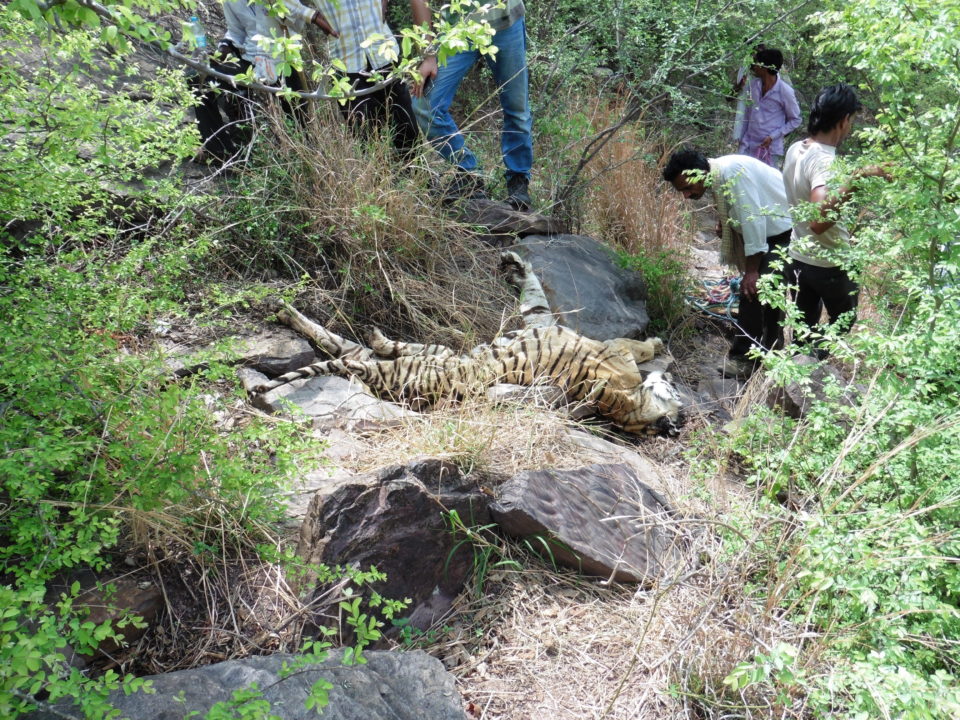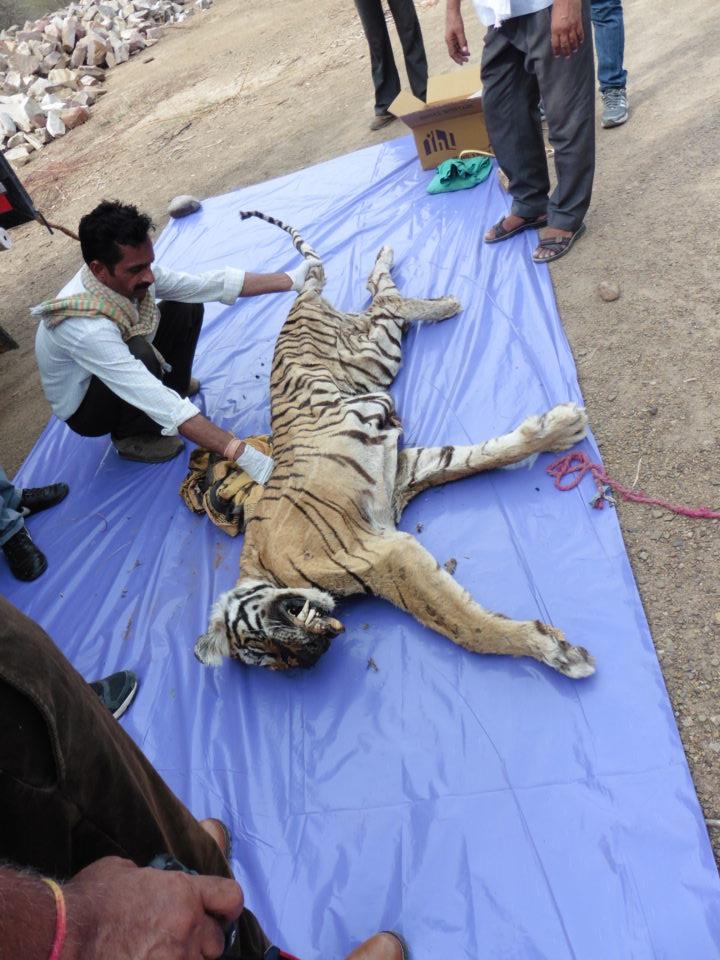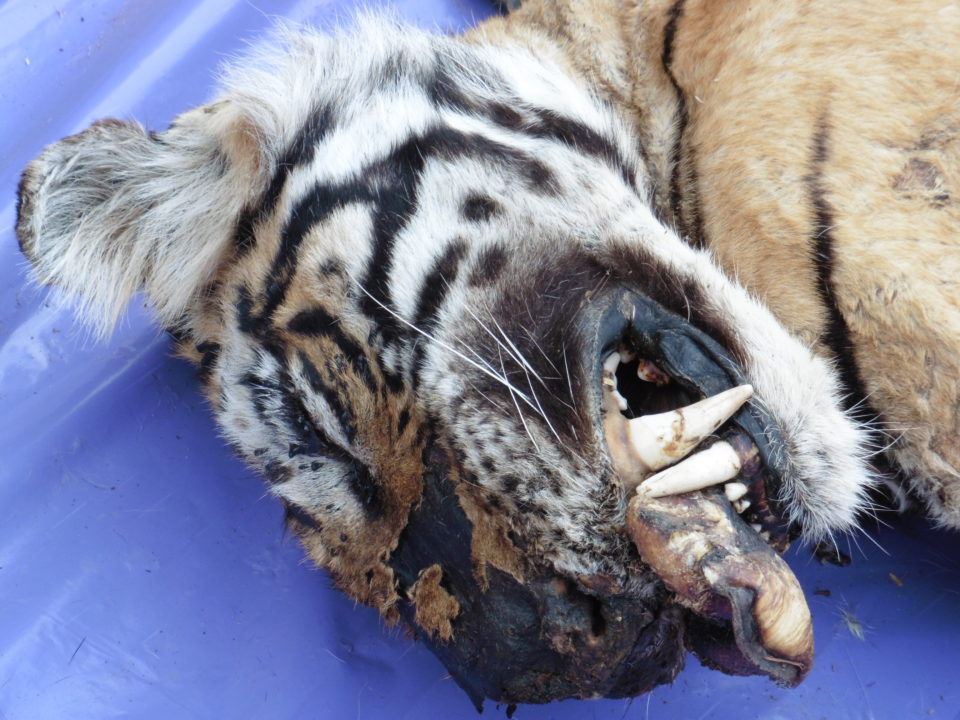Pulled in for an emergency, a field biologist finds a scalpel thrust into her hands and told to extract pieces of the intestine and lung tissues from the carcass of a dead tigress for the pathology tests.
Written by Priya Ranganathan
Five-thirty in the morning is far too early for a telephone call.
I cracked open an eyelid and picked up the buzzing mobile from the bedside table. “Hello?”
“Madam, get up, you have duty,” replied the voice of the office driver, Javed Bhai.
I checked the time on the screen. “This early? What happened?” At the same time, I was sitting up, finding my glasses, reaching for my bottle of water. Field duty was a break from the mundanities of office life, and field work in Ranthambhore almost always promised the sighting of a tiger.
“The Forest Department called. Dead tigress near Sanwata. They need you to go to the site.”
I was now fully awake and changing into my field clothes. “A tigress? What happened? Poaching?”
“They can’t say, Madam. We have to go.”

© Priya Ranganathan
I couldn’t quite understand my role in this curious case, but I was nonetheless raring to go. A field visit is always a breath of fresh air – literally! My fieldwork in Rajasthan had already exposed me to the beauty of the state’s wilderness and arid ecosystem in the early hours of the dawn. I had fallen in love with the blue-grey nilgai drinking water from sandy anicuts, with the large eyes of the spotted deer that glimpsed us well before we saw them, with the mournful howls of jackals on the hunt.
Walking through the sandy ravines that formed the fringes of Ranthambhore Tiger Reserve, I learnt to distinguish between the pugmarks of Indian wolves, jackals, and foxes; to identify the scat of tigers, leopards, hyenas, and other wildlife. I also learnt the art of remaining absolutely still at the sight, sound, or smell of wildlife, and with my drab field clothing, I taught myself to blend into my surroundings. The scent of Rajasthan’s soil was my sole companion on many of these lessons.
Within moments, I was dressed in my field gear and informed our cook that I would not be in for lunch. Sudden honking alerted me, and I ran outside to our rickety jeep, which was idling by the door. Javed Bhai and I set off, stopping briefly to pick up Pradeep, another senior at the organization. The ride to Sanwata was absolutely gorgeous, especially as the pre-monsoon rain had released trapped scents from the soil, perfuming the air. We bounced down the dirt road, swerving around goats, cattle, buffaloes, camels, and humans alike. The camels, decorated with colourful strings and heavy ankle bells, were quite the sight, standing out against the stark landscape as they pulled heavy wooden carts down the path. Their disdainful expressions and sedate trot indicated a less jovial personality than one might expect given their festive décor.
Chambal & Banas
We passed through tiny villages and endless fields, prompting curious glances from village folk. Sanwata was one of the villages on the Banas River, a tributary of the Chambal River. The Chambal is the official border between the Indian states of Rajasthan and Madhya Pradesh and is also home to one of the world’s most-endangered crocodilians, the gharial. The Banas is diminutive in comparison, but is the lifeblood of Ranthambhore, allowing the forests of this tiger reserve to retain their greenery and survive the harsh summer months. It runs dry in the summer, as do most rivers in arid regions, and as we drove through the forest road, we occasionally caught glimpses of its vast, empty expanses, the only thing marking the depression in the soil as a riverbed being the steep riverbank on either side and the lack of vegetation or habitation in the centre of the depression.
As we wound through the forest, we were treated to the sight of a few of the forest’s denizens – spotted deer, sambar, wild boar, a porcupine, and more peacocks and rhesus macaques than I had ever wanted to see. At last, we approached a bend in the river and Javed Bhai steered the jeep into the dry riverbed, sending up spirals of dust as the tires spun, trying to find traction. The Banas riverbed really was enormous up at close quarters. I stared hard at the soil below us, trying to find signs of water, but there were none. The river was well and truly dry.
No wildlife was to be seen. Javed Bhai switched the jeep to four-wheel drive and steered it up the bank onto the other side, taking a dubious path through equally-dubious terrain with extreme confidence (that thankfully was not misplaced).
Sanwata was nondescript, as far as villages go. However, it had quite the reputation as a village full of people who took pleasure in beating and tying up innocent forest guards or anyone who stood up for wildlife. To a novice, Sanwata looked like any other hamlet, a splash of bright colours in a dry, colourless landscape. We took the jeep to the end of the village road, where mud houses gave way to a steep hill. Here, we parked and jumped out of the jeep, the men taking the lead and leaving me to follow them. Wisely, I had packed a bandanna and thought to bring my daypack with a water bottle, energy bars, and a first-aid kit, along with my field notebook, pencils, pens, and other supplies.
I joined Pradeep and Javed Bhai, who were standing with a few village men, who eyed me suspiciously. Pradeep briefly introduced me as a co-worker and, more importantly for the case at hand, a biologist who was needed at the site where the tigress was found dead. That was good enough for the villagers; they pointed to a rocky goat path (barely a path, really) winding up the shrubby hillside and told us to look out for a small pool of water and a cave to the left about halfway up the hill. I squinted up the hill; the place they were indicating to be our destination seemed to be poised on the least-stable part of the hillside. Oh well, the perils of fieldwork are many, and one can only grumble so much. Setting out determinedly, I started up the path, leaving the men to follow.
The path was quite easy for an energetic twenty-something year-old, and I soon left poor Pradeep Sir and Javed Bhai far behind. Down below, I could see the winding Banas, and the many shades of brown that painted this land. Dots of green – shrubs and hardy trees – brought life to the soil, and colourful houses broke up the monotony of browns and greens. I found myself humming as I climbed higher. I could see no people, just the occasional bird, lizard, and flowering plant. Finally, the sound of voices murmuring pulled my attention away from the endless sky and the natural beauty around me. Forest guards. They stood when I approached, evidently confused to see a girl hiking alone. Girls in this part of the country did not do such things. My field attire, however, was noticed by one of the men, and he saluted me. “Yes, Madam?” he asked.
Cordoning off the site
“I am the biologist sent to look at the dead tigress,” I said, aware of how ridiculously grand I sounded. But the men seemed convinced. Perhaps it was the nerdy air that surrounded me. They parted ways, revealing a small water hole; surprisingly, this one was brimming with water! Behind the men was a dark cave. This was clearly the spot to which the villagers had referred. I walked over to the pool and glanced around. There were pug marks ahead, but some were distorted by human footprints over them. Something would clearly have to be done to ensure that the investigation could occur in as much detail and as accurately as possible.

© Priya Ranganathan
“Do we have police tape?” I asked the nearest forest department officer. He nodded, and indicated to one of his officials, who produced a thick roll of yellow tape. I quickly outlined my plan of surrounding the site with tape to prevent further distortion of evidence. The officers were co-operative, and the site was quickly sealed. The lead forest guard accompanied me as I walked around the perimeter of the cordoned site. The first step was talking out loud; I had to say everything that came to my mind as I assessed the site. I had no concept of how to do this, but the forest guard kindly informed me of the procedure. Though the entire process brought back strong memories of vivas (oral examinations), I began reciting each thought that came to my head.
“There are pug marks leading from the top right corner into the site. Pug marks lead to the water hole. Body imprint, deeper pug marks indicating resting posture of the tigress. Sloth bear pug marks over tigress pug marks leading to and from cave by the water hole. Cave entrance has black fur liberally sprinkled. Foul odour from cave. Does not seem like the tiger’s den, given prior range tracking of this particular tigress. Dried blood stain on a rock by the water hole. Claw rake marks traveling down the steep rock face in the centre of the site that abruptly end when the rock face changes direction and angles steeply. The tigress’ body was found against a jagged rock about 200 metres from the rock face, legs thrown at an unnatural angle. Dent on skull where the head was resting against the rock, and dark bloodstains on the rock edge and the surrounding ground. It seems likely that the tigress struck her head against the rock edge and died of internal brain haemorrhaging. Veterinary assessment is required to verify this diagnosis.”
Once this entire assessment was recorded by the listening forest guard, I snapped photographs of the site, including the position of the deceased tigress. Then, we opened the safety tape and the field team entered the site to strap the tigress to a stretcher and remove her to the forest department office for the veterinary assessment. Pradeep and I were told to be present for the assessment, and we followed the stretcher to the forest department van. We followed the van to the forest department field office, a lovely set of buildings surrounded by flowering trees – a burst of colour in the arid landscape. Forest guards stood up to salute us as we stepped out of our jeep.
The first cut
I was looking around for the veterinarian when Pradeep tapped me on the shoulder and pointed to a growing crowd around the tigress’ body. “He’s over there,” he said. I walked over and found myself face-to-face with a purple-shirted, balding man of about thirty-five years. He held a medical bag in one hand and his other hand was shoved deep into the pocket of his skinny jeans. Quite frankly, he bore no resemblance to a veterinarian. But everyone at the site was fawning over him. I walked up to him and shook hands briskly; he pointed to the guards uncovering the tigress and said: “I don’t want too many hands messing up this autopsy. You wear this pair of gloves. Have you used a scalpel?”
“Yes, in bio practicals... ” I started to say, but he had already shoved a scalpel into my hand and knelt by the now-uncovered tigress’s carcass. The stench up close was unbearable; I quickly bound my handkerchief around my nose and made sure that my hair was well out of the way. I didn’t fancy my curls getting a liberal soaking in its guts. I squatted by the tigress as well. The veterinarian cast me an impatient glance. “What are you waiting for? Make a lateral incision!”
“The entire length?” I was a bit alarmed. My biology dissection skills ended at house cats, thanks to 12th grade biology. Big cats, however physiologically similar to their tiny cousins, involved a lot more cutting and a prodigious amount of skill.
“I need a gastro-intestinal cut,” the vet snapped. “Start at the jaw and get going.”
There was nothing to it. I hastily picked up the scalpel, which I had dropped, and marked a starting point at the poor tigress’ jawline. Uttering a silent prayer to whichever god presided over surgical malpractice, I began cutting. The stench grew to nearly solid proportions. I gagged once, and then, seeing the vet’s expression, shut my mouth and focussed on breathing as minimally as possible. Snip, snip, snip. The tigress – poor dear – would have been easier to cut with a chainsaw than with the puny scalpel. I doggedly (cattedly?) chopped away. Finally, I had a sizeable incision in the tigress’ underside. Unfortunately, in the process, I had nicked the tigress’ stomach, and a foul-smelling substance was oozing from that organ. I shuffled backwards as the vet moved to take my place. He gave me a brief nod, then wrinkled up his nose in disgust and indicated the intestine.
“Cut a small sample of the intestines and of the lung tissue.”
I was horrified. Intestines I could handle, but how did one sample lung tissue? Time to find out, I supposed. The scalpel in my hand, I knelt by the tigress once again and inserted my hand into the cut, widening it. The stench was overpowering. I began sawing at the intestines, trying to cut a fair-sized chunk. Unfortunately, the tigress had not passed scat before her untimely death, and the moment I severed the intestines, stool began to ooze from the organ. My gloves were now coated in a healthy layer of brown goo. Retching inwardly, I pulled off the intestinal sample and laid it carefully on the tarpaulin. I indicated the bucket of water and asked a forest guard to pour water on my soiled hands. Then, I went for the lung sample. This proved to be far more difficult, and the vet had to walk me through the specific procedure. I am sure my cuts would not have passed surgical muster. But in the end, I had a sizeable sample of lung tissue and a headache to accompany it.
“Not bad,” said the vet. “Now, do an external check.”
This I could do. I quickly checked the tigress’ teeth, counting how many of each type were there and their condition. I checked her skin, her paws, her claws, her eyeballs, and her tail, looking for nicks, missing parts, and peeling. One of her teeth was missing, and two were chipped. Her paws were intact. The skin on her nose was peeling, and bits of her fur as well. These observations were recorded by a waiting forest guard. Finally, the vet grunted, and I stood up, relieved. He took my place and proceeded to do the same steps that I had just completed – so that we had two separate sets of samples from two separate sources. His cuts were a lot neater than mine, and his hand moved across the tigress’ body like a hand over the typewriter.

© Priya Ranganathan
Finally, the veterinarian rose and nodded at the range officer. He, in turn, nodded at two forest guards, who moved towards the tarpaulin upon which the tigress’s remains lay. I stepped back into the crowd thankfully, glad to no longer be in the spotlight. The guards carefully lifted the tarpaulin and carried it around to the back of the maidan. The entire crowd followed them.
Solemn end
In the back of the dirt maidan was a large pile of sticks. A pyre. Two more forest guards helped to slide the tigress onto the second layer of sticks, and the rest of the logs were piled quickly into a tepee over the animal’s body. “We burn any remaining body parts to prevent poachers from getting their hands on the remains,” one forest guard murmured quietly to me. It made sense, given the crowd of villagers who had watched us carry the body down from Sanwata. Anyone could be a poacher, and anyone could turn informant to a poacher.
A match was tossed onto the pyre, and almost immediately, the carcass began to burn. The forest guards saluted the pyre solemnly, then delicately covered their noses with kerchiefs. The stench must have been terrible, but my senses were dulled at the end of the long day. It was a lot to take in.
Slowly, the crowd dispersed, people secretly eager to get away from the odour of burning flesh. My team and I also returned to the shade of a peepal tree, where the Field Director of Ranthambhore Tiger Reserve, Mr. Y.K. Sahu, waited for us. At his behest, I quickly wrote down my observations across the day and took down his email address; he wanted a report from me on the case as well as all relevant photographs. After assuring him that I would be in touch, I thankfully climbed back into the jeep and Javed Bhai revved up the engine. Our cranky old Gypsy rolled off in a cloud of dust, leaving behind a crowd of khaki-clad men under a peepal tree and the burning remains of an 11-year-old tigress.
Maybe one day in the future, I will once again pick up a scalpel and brace myself to perform an autopsy on an animal. And maybe that day I will manage to avoid surgical malpractice.
Priya Ranganathan is a researcher with the Ashoka Trust for Research in Ecology and the Environment (ATREE), Bengaluru. She works on the ecology and restoration of wetland ecosystems in India. A geologist by training, she obtained her M.Sc. in Ecosystem Science and Conservation from Duke University in 2017 and enjoys writing, reading, and dancing in her free time.